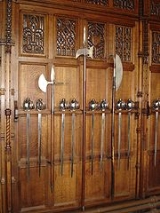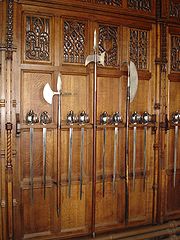
Lochaber axe
Encyclopedia


Scotland
Scotland is a country that is part of the United Kingdom. Occupying the northern third of the island of Great Britain, it shares a border with England to the south and is bounded by the North Sea to the east, the Atlantic Ocean to the north and west, and the North Channel and Irish Sea to the...
around 1300. The name of the weapon derives from Lochaber
Lochaber
District of Lochaber 1975 to 1996Highland council area shown as one of the council areas of ScotlandLochaber is one of the 16 ward management areas of the Highland Council of Scotland and one of eight former local government districts of the two-tier Highland region...
, an area in the western Scottish Highlands
Scottish Highlands
The Highlands is an historic region of Scotland. The area is sometimes referred to as the "Scottish Highlands". It was culturally distinguishable from the Lowlands from the later Middle Ages into the modern period, when Lowland Scots replaced Scottish Gaelic throughout most of the Lowlands...
, as the weapon was employed principally by the Scottish highlanders, who (generally without any cavalry of their own) required armament against cavalry
Cavalry
Cavalry or horsemen were soldiers or warriors who fought mounted on horseback. Cavalry were historically the third oldest and the most mobile of the combat arms...
.
The axe itself is similar to tools used with crops, such as the scythe
Scythe
A scythe is an agricultural hand tool for mowing grass, or reaping crops. It was largely replaced by horse-drawn and then tractor machinery, but is still used in some areas of Europe and Asia. The Grim Reaper is often depicted carrying or wielding a scythe...
, which is designed for reaping. The hook on the back bears a passing resemblance to a shepherd's crook
Crook
- Places :* Crook, County Durham, England, United Kingdom* Crook, Cumbria, England, United Kingdom* Crook, Devon, England, United Kingdom* Crook Inn, Scotland, United Kingdom* Crook, Colorado, United States* Crook County, Oregon, United States...
, although within agriculture a smaller hook such as this may have been used in order to lift and carry tied bundles of a harvested crop or pull down tree branches. It is possible, then, that earlier Lochaber axes, like the billhook
Billhook
The billhook is a traditional cutting tool known and used throughout the world, and very common in the wine-growing countries of Europe, used widely in agriculture and forestry The billhook (also bill hook – although this more usually refers to either a metal or plastic hook used to hold bills,...
, served a dual purpose as both weapons and farming tools.
Specifics of the weapon
The Lochaber axe took many incarnations, although all of them had a few elements in common. It was a heavy weapon, used by infantry for a defence against cavalry and as a pikePike (weapon)
A pike is a pole weapon, a very long thrusting spear used extensively by infantry both for attacks on enemy foot soldiers and as a counter-measure against cavalry assaults. Unlike many similar weapons, the pike is not intended to be thrown. Pikes were used regularly in European warfare from the...
against infantry
Infantry
Infantrymen are soldiers who are specifically trained for the role of fighting on foot to engage the enemy face to face and have historically borne the brunt of the casualties of combat in wars. As the oldest branch of combat arms, they are the backbone of armies...
. Like most other polearms of the time, it consisted of two parts: shaft and blade. The shaft was usually some five or six feet (1.5 or 1.8 m) long, and mounted with a blade of about 18 inches (45 cm) in length which usually resembled a bardiche
Bardiche
A bardiche or berdiche is a type of glaive polearm known in the 16th and 17th centuries in Eastern Europe and Russia. Ultimately a descendant of the medieval sparth , the bardiche proper appears after 1500, but there are numerous medieval manuscripts that depict very similar weapons beginning ca....
or voulge
Voulge
thumb|VoulgesA voulge is a type of polearm that existed alongside the similar glaive in medieval Europe. Superficially, a voulge might strongly resemble a glaive, but there are some notable differences in construction...
in design. The blade might be attached in two places and often had a sharp point coming off the top. In addition a hook (or cleek) was attached to the back of the blade. A butt spike was included as a counterweight to the heavy axe head. Langlets were incorporated down each side of the shaft to prevent the head from being cut off.
Another idea is that the Lochaber is just the Scottish name for the weapon known as a bardiche
Bardiche
A bardiche or berdiche is a type of glaive polearm known in the 16th and 17th centuries in Eastern Europe and Russia. Ultimately a descendant of the medieval sparth , the bardiche proper appears after 1500, but there are numerous medieval manuscripts that depict very similar weapons beginning ca....
; these also occasionally had a backspike or hook too.
http://onirym.online.fr/v3/imgs/Bardiche.jpg
Use
In hand-to-hand combat, the axe, in common with other polearms such as the halberdHalberd
A halberd is a two-handed pole weapon that came to prominent use during the 14th and 15th centuries. Possibly the word halberd comes from the German words Halm , and Barte - in modern-day German, the weapon is called Hellebarde. The halberd consists of an axe blade topped with a spike mounted on...
, has a spike on the end, to be used on close combat in a thrusting motion. The axe on the side, coupled with the long pole, delivered a powerful blow to infantry or dismounted cavalry.
Finally, the hook on the back allowed infantry to hook the cavalry off their horses. To accomplish this, as the cavalry charged, the highlanders would suddenly change formation from a large body, into smaller bodies of men with clear channels between them. The horses would naturally go into these channels, and the foot soldiers would hook the cavalry off their horses, then use their axes on them with devastating effect. The hook supposedly could also be used for scaling walls.
In history
In about 1570, during the Battle of Bun GarbhainBattle of Bun Garbhain
The Battle of Bun Garbhain was a Scottish clan battle fought in 1570, in the Scottish Highlands, between the Clan Cameron and the Clan Mackintosh....
between Clan Cameron
Clan Cameron
Clan Cameron is a West Highland Scottish clan, with one main branch Lochiel, and numerous cadet branches. The Clan Cameron lands are in Lochaber and within their lands is the mountain Ben Nevis which is the highest mountain in the British Isles. The chief of the clan is customarily referred to as...
and Clan Mackintosh
Clan MacKintosh
Clan Mackintosh is a Scottish clan from Inverness with strong Jacobite ties. The Mackintoshes were also chiefs of the Chattan Confederation.-Origins:...
, the Lochaber axe was used by the Camerons. Donald 'Black Taylor of the Axe', son of the 14th chief of Clan Cameron, became notable for his fighting prowess with the axe and became a hero for felling the chief of Clan Mackintosh with it.
Before the populist uprising known as the Jacobite Rising of 1745
Jacobite Rising of 1745
The Jacobite rising of 1745, often referred to as "The 'Forty-Five," was the attempt by Charles Edward Stuart to regain the British throne for the exiled House of Stuart. The rising occurred during the War of the Austrian Succession when most of the British Army was on the European continent...
or, simply, "the '45," Lochaber axes were relegated to the Scottish constabulary, and were somewhat viewed as the police baton of the day. In 1745, Prince Charles Stewart raised an army of Scots to oust the Hanoverian King George from the Throne of England and place his father, James VIII of Scotland, on the throne. Many of the Prince's army equipped themselves with Lochaber axes, until such a time they could discard the axes for captured muskets and bayonets or arms supplied by the French.
By around 1767, the Lochaber axe was used mainly as a ceremonial weapon by the town guard of Edinburgh, Scotland.

